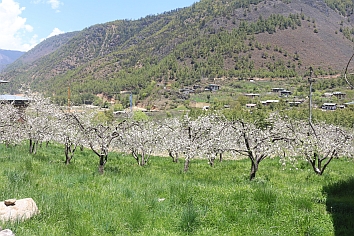Pollinators and crops in Bhutan: insect abundance improves fruit quality in Himalayan apple orchards
DOI:
https://doi.org/10.26786/1920-7603(2022)670Keywords:
biodiversity, agroecology, community composition, Hymenoptera, Diptera, LepidopteraAbstract
Apples are one of the most important global crops that relies heavily on insect pollination, which has been shown to increase apple production and value. However, recent reports indicate that apple production has been declining in certain regions, including in Bhutan. One of the potential causes of declining production are pollination deficits driven by a low abundance and diversity of pollinators, a phenomenon that has received little attention in Bhutan to date. Here, we present the first study examining the diversity of flying insects in Bhutanese apple orchards in relation to apple quality. During the apple flowering season, 1,006 insects comprising 44 unique (morpho-)species from the orders Hymenoptera, Diptera, and Lepidoptera were recorded using a standardized method of passive and active trapping within nine different orchards in Thimphu, Paro, and Haa districts, in the western part of Bhutan. During the harvest season, 495 apples were collected from these nine orchards, and we measured five different parameters; weight, size, sugar concentration, seed number, and malformation score. The most dominant flower visitors across all orchards were honey bees (mostly Apis mellifera, followed by A. cerana and A. dorsata). Orchards with a higher abundance of flying insects (both managed and wild) had better apple quality (weight, size and sugar concentration). Contrary to reports from other regions of the world, flower visitor diversity did not correlate with the quality of the apples. This represents the first study reporting on apple pollination in Bhutan and highlights the importance of pollinators and reinforces the need to develop pollinator friendly practices to ensure sustainable apple production.

Published
How to Cite
Issue
Section
License
Copyright (c) 2022 Kinley Dorji, Sonam Tashi, Jacobus C. Biesmeijer, Nicolas Leclercq, Nicolas J, Vereecken, Leon Marshall

This work is licensed under a Creative Commons Attribution 4.0 International License.
JPE is an open access journal which means that all content is freely available without charge to the user or his/her institution.
Authors who publish with this journal agree to the following terms:
1) Authors retain copyright and grant the journal right of first publication with the work simultaneously licensed under a Creative Commons Attribution License that allows others to share the work with an acknowledgement of the work's authorship and initial publication in this journal.
2) Authors are able to enter into separate, additional contractual arrangements for the non-exclusive distribution of the journal's published version of the work (e.g., post it to an institutional repository or publish it in a book), with an acknowledgement of its initial publication in this journal.
3) Authors are permitted and encouraged to post their work online (e.g., in institutional repositories or on their website) prior to and during the submission process, as it can lead to productive exchanges, as well as earlier and greater citation of published work (See The Effect of Open Access).
To assure a broader targeted audience, content will be included into databases (such as EBSCO) and directories (such as DOAJ).











